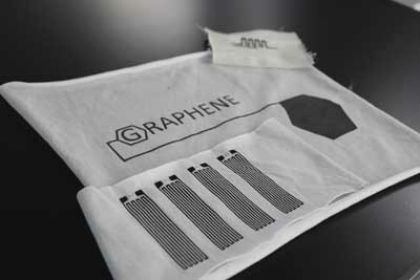|
NOVIDADES
The rapid development of wearable technology has received another boost from a new development using graphene for printed electronic devices. New research from The University of Manchester has demonstrated flexible battery-like devices printed directly on to textiles using a simple screen-printing technique.  Graphene printed on cotton. Image: University of Manchester The current hurdle with wearable technology is how to power devices without the need for cumbersome battery packs. Devices known as supercapacitors are one way to achieve this. A supercapacitor acts similarly to a battery but allows for rapid charging which can fully charge devices in seconds. Now a solid-state flexible supercapacitor device has been demonstrated by using conductive graphene-oxide ink to print onto cotton fabric. As reported in the journal 2D Materials ("Ultraflexible and robust graphene supercapacitors printed on textiles for wearable electronics applications") the printed electrodes exhibited excellent mechanical stability due to the strong interaction between the ink and textile substrate. Further development of graphene-oxide printed supercapacitors could turn the vast potential of wearable technology into the norm. High-performance sportswear that monitors performance, embedded health-monitoring devices, lightweight military gear, new classes of mobile communication devices and even wearable computers are just some of the applications that could become available following further research and development. To power these new wearable devices, the energy storage system must have reasonable mechanical flexibility in addition to high energy and power density, good operational safety, long cycling life and be low cost. Dr Nazmul Karim, Knowledge Exchange Fellow, the National Graphene Institute and co-author of the paper said: “The development of graphene-based flexible textile supercapacitor using a simple and scalable printing technique is a significant step towards realising multifunctional next generation wearable e-textiles.” “It will open up possibilities of making an environmental friendly and cost-effective smart e-textile that can store energy and monitor human activity and physiological condition at the same time”. Graphene-oxide is a form of graphene which can be produced relatively cheaply in an ink-like solution. This solution can be applied to textiles to create supercapacitors which become part of the fabric itself. Dr Amor Abdelkader, also co-author of the paper said: “Textiles are some of the most flexible substrates, and for the first time, we printed a stable device that can store energy and be as flexible as cotton. “The device is also washable, which makes it practically possible to use it for the future smart clothes. We believe this work will open the door for printing other types of devices on textile using 2D-materials inks." University of Manchester. Posted: Aug 11, 2017. Assuntos Conexos: |
|||||||||||||||||||||||||